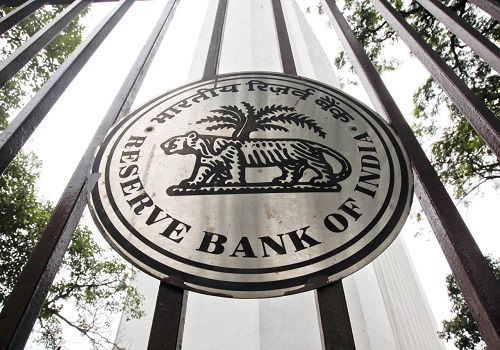Turmeric trading range for the day is 13368-14284 - Kedia Advisory

Gold
Gold prices faced a downturn, closing down by -1.19% at 62507, as the U.S. dollar retained its gains ahead of crucial U.S. labor market data and the release of FOMC meeting minutes. The uncertainty surrounding the Federal Reserve's plan to begin rate trimming in 2024 contributed to a prevailing risk-off sentiment in financial markets. Fed Chair Jerome Powell emphasized that achieving price stability remains the central bank's primary objective. Market expectations, reflected in the CME FedWatch tool, indicate a 70% probability of a 25 basis points interest rate reduction to 5.00-5.25%, with a similar likelihood of further rate cuts in May. The HCOB Eurozone Manufacturing PMI showed a slight increase to 44.4 in December, surpassing preliminary estimates, signaling signs of improvement in sub-indices like new orders and purchasing activity, along with elevated business confidence. In the gold market, China's net imports via Hong Kong rose approximately 37% in November compared to the previous month, reaching 36.801 metric tons. This surge in total gold imports via Hong Kong, up 37% at 46.049 tons, highlights sustained demand from the world's leading gold consumer. From a technical perspective, gold experienced long liquidation, with a -12.94% drop in open interest, settling at 12974. Despite the decrease in open interest, gold prices fell by -750 rupees. The support level is identified at 62165, and a breach could lead to a test of 61830 levels. Resistance is anticipated at 63090, with a potential breakthrough pushing prices to test 63680.
Trading Ideas:
* Gold trading range for the day is 61830-63680.
* Gold dropped as the dollar rose ahead of U.S. labor market data and FOMC meeting minutes
* Risk-off mood prevailed in financial markets as doubts emerged over just when the Fed plan to begin trimming rates in 2024.
* Futures markets see a 70% chance of a 25 basis points rate cut at the March meeting, according to CME's FedWatch Tool.
Silver
Silver prices experienced a decline of -2.38%, settling at 72333, primarily influenced by the resurgence of the U.S. dollar index during the week. The anticipation of Friday's U.S. employment report for December, with an expected non-farm jobs increase of 170,000, added to market uncertainty following November's rise of 199,000 jobs. Geopolitical tensions in the Middle East escalated as U.S. helicopters thwarted an attack by Iran-backed Houthi militants on a Maersk container vessel in the Red Sea, a crucial trade route linking Europe and Asia. Market participants should brace for heightened volatility as a series of economic reports are set for release. China's manufacturing PMI, indicating an expansion at 50.8 in December, portrayed stronger gains in output and new orders, but subdued business confidence for 2024. In contrast, broader Asian factory activity weakened, signaling a tentative start for the region's manufacturing powerhouses in 2024, influenced by China's uneven economic recovery. Technically, the silver market witnessed fresh selling, with a notable increase in open interest by 28.55%, settling at 21533. Despite the rise in open interest, silver prices experienced a decline of -1762 rupees. The support level is identified at 71635, and a breach could lead to a test of 70945 levels. Resistance is anticipated at 73570, and a breakthrough may propel prices to test 74815. The market reflects a delicate balance between geopolitical developments, economic indicators, and technical factors influencing silver's price trajectory.
Trading Ideas:
* Silver trading range for the day is 70945-74815.
* Silver prices dropped pressured by a resurgence in the U.S. dollar index this week.
* Middle East tensions escalated after U.S. helicopters repelled an attack by Iran-backed Houthi militants in the Red Sea.
* Investors should brace for volatility this week as various economic reports are lined for release.
Crude oil
Crude oil prices surged by 2.15% to settle at 6071 per barrel, driven by disruptions in Libya's top oilfield and escalating tensions in the Red Sea. Protests led to a partial reduction in production at the Sharara oilfield, impacting Libya's output by 300,000 barrels per day (bpd). The conflict in the Gaza Strip, extending into Lebanon with the killing of Hamas' deputy leader, intensified geopolitical concerns, further supporting oil prices. On the supply side, expectations of sufficient oil availability in the first half of 2024 tempered prices, anticipating discussions at the upcoming OPEC+ Joint Ministerial Monitoring Committee meeting in February. Additionally, the slight drop in U.S. crude oil output in October, the first monthly decline since April, contributed to market dynamics. The U.S. Energy Information Administration revised September's output to 13.252 million bpd. In terms of transportation, U.S. crude oil shipments via rail in October increased by 17,000 bpd compared to the previous month. Domestic shipments rose by 19,000 bpd, while Canadian shipments to the U.S. declined by 2,000 bpd. From a technical perspective, the market experienced short-covering with a decrease in open interest by -10.88% to settle at 14,660. Despite this, crude oil found support at 5882, with a potential downside test at 5693. Resistance is anticipated at 6174, and a breakthrough could lead to a testing of 6277. The overall market sentiment reflects a complex interplay of geopolitical events, supply concerns, and technical factors influencing crude oil prices.
Trading Ideas:
* Crudeoil trading range for the day is 5693-6277.
* Crude oil gains as supply concerns deepen with Libyan oilfield disruption
* US crude oil output falls slightly in October, first monthly decline since April
* US shipments of crude oil via rail increase in October
Natural gas
Natural gas prices surged by 4.99%, settling at 223.1, driven by a decrease in daily output and revised forecasts indicating colder weather in mid-January. Despite initial predictions of milder weather this week and the next, along with a slight decline in gas flow to U.S. liquefied natural gas export facilities, the market experienced an upswing. The recent increase in natural gas prices occurred even as the weather forecast suggested lower heating demand. Mild weather in the short term allows utilities to draw less gas from storage due to reduced heating requirements. The lower 48 U.S. states witnessed a decline in average gas output to 107.5 billion cubic feet per day (bcfd) in January from the monthly record of 108.5 bcfd in December. Meteorologists expect near-normal to warmer conditions until January 12, followed by colder-than-normal weather from January 13 to 18. Anticipating this colder spell, financial firm LSEG revised its forecast, predicting an increase in U.S. gas demand in the Lower 48, including exports, from 132.7 bcfd this week to 133.7 bcfd next week. Despite this adjustment, the forecasts remained lower than earlier projections. U.S. pipeline exports to Mexico declined to an average of 4.2 bcfd in January, down from 4.6 bcfd in December and a record 7.0 bcfd in August. From a technical standpoint, the market is undergoing short covering, with a drop in open interest by -19.25% to settle at 23622. Natural gas is finding support at 214.6, and a breach of this level could lead to a test of 206.1. On the upside, resistance is likely at 229.2, and a move above could pave the way for prices testing 235.3.
Trading Ideas:
* Naturalgas trading range for the day is 206.1-235.3.
* Natural gas prices increased due to decline in daily output and colder weather forecasts.
* Milder weather and lower heating demand expected this week and next.
* Gas flowing to U.S. LNG export plants declined slightly.
Copper
Copper prices declined by -0.31%, settling at 727.6, influenced by a strengthening dollar and concerns about demand in China, exacerbated by weak industrial sector data. China's manufacturing activity contracted for the third consecutive month in December, falling to 49.0 from the previous month's 49.4, raising uncertainties about the country's economic recovery. Worries about potential surpluses in the copper market were evident in the discount for cash over the three-month contract, trading at $104 per ton, near the 31-year lows seen in November. China's reduced appetite for metal purchases, following a seasonally strong period for production to meet year-end targets, contributed to this trend. The Yangshan copper premium, reflecting import demand, fell to $67.50 per ton, down 67% from a month earlier. The rebounding US dollar, as traders assessed the extent of the Federal Reserve's loosening in the coming year, contributed to the pressure on copper prices. The dollar's rise impacted the purchasing power of importers, leading to lower prices for commodities priced in the currency. Despite some uncertainties, copper prices saw a slight increase last year, with market participants building long positions amid warnings of a potential supply shortage in the long term. This anticipation is driven by the crucial role copper plays in the global electrification movement. Technically, the copper market is undergoing fresh selling, with a gain in open interest by 0.35% to settle at 5193. The current support for copper is at 724.9, with a potential test of 722.1 levels, while resistance is likely at 730.1.
Trading Ideas:
* Copper trading range for the day is 722.1-732.5.
* Copper prices dropped as dollar rose and concerns about demand in China grew.
* China's manufacturing activity shrank for a third straight month in December.
* Expectations of copper market surpluses reflected in low cash over three-month contract.
Zinc
Zinc prices experienced a decline of -0.91%, settling at 228.45, influenced by China's official PMI falling to 49 in December from the previous month, reinforcing expectations for additional stimulus measures from the government. In contrast, the Caixin/S&P Global manufacturing PMI rose to 50.8, surpassing market forecasts and indicating a slight recovery. The industrial outlook improved, driven by hopes of early interest rate cuts by major central banks and a fuller economic recovery in China, the top consumer of zinc. Data from the International Lead and Zinc Study Group (ILZSG) revealed that the global zinc market deficit eased to 52,500 metric tons in October, down from a deficit of 62,000 tons in September. However, for the first 10 months of 2023, a surplus of 295,000 tons was recorded, compared to a deficit of 33,000 tons in the same period of 2022. Zinc inventories in Shanghai Futures Exchange-monitored warehouses fell by -16.60% from the previous Friday. In November 2023, China's refined zinc output decreased by 4.23% month-on-month to 579,000 metric tons. Despite this decline, the year-on-year increase was 10.62%, reaching around 6.03 million metric tons from January to November. Technically, the zinc market is undergoing long liquidation, with a drop in open interest by -8.4% to settle at 4341. The current support for zinc is at 226.8, and a break below could test 225 levels, while resistance is likely at 230.5. A move above could see prices testing 232.4. The market reflects a delicate balance between macroeconomic indicators and supply dynamics, influencing the overall price performance of zinc.
Trading Ideas:
* Zinc trading range for the day is 225-232.4.
* Zinc prices dropped as China's official PMI fell to 49 in December.
* Global zinc market deficit eased to 52,500 metric tons in October.
* Year-on-year increase of 10.62% in China's refined zinc output.
Aluminium
Aluminium prices experienced a decline of -0.5%, settling at 207.2, driven by a 28% increase in stocks in LME-approved warehouses since December 6, reaching 566,375 tons. The surge in inventory levels undermined sentiment on aluminium prices, impacting the metal used extensively in the power, construction, and packaging industries. However, the downside was limited by concerns about the supply of feedstock alumina following a blast last month that damaged fuel stocks at the main terminal in Guinea, the world's third-largest producer of alumina raw material bauxite. The Caixin China General Manufacturing PMI for December inched up to 50.8, exceeding market forecasts and reaching the highest reading since August. Despite official data indicating a contraction in Chinese manufacturing activity in December, a private survey suggested unexpected acceleration in the country's manufacturing sector growth. This led to speculation that the People’s Bank of China might ease policy further in 2024 to support the economic recovery. Technically, the aluminium market is undergoing long liquidation, with a 5.31% drop in open interest to 4406. Aluminium's current support is at 206.1, and a break below could test 204.9 levels, while resistance is likely at 208.3. A move above could see prices testing 209.3. The market reflects a delicate balance between concerns about global aluminium stocks and the impact of geopolitical events on the supply chain, influencing the overall price performance of aluminium.
Trading Ideas:
* Aluminium trading range for the day is 204.9-209.3.
* Aluminium prices dropped due to increased stocks in LME-approved warehouses.
* Chinese manufacturing activity contracted in December, but private survey showed unexpected growth.
* Expectations of further policy easing by the People's Bank of China.
Cotton
Cotton prices, represented by Cottoncandy, recorded a marginal uptick of 0.04%, settling at 56180. The Cotton Association of India (CAI) maintained its pressing estimate for the 2023-24 season at 294.10 lakh bales of 170 kg each. The CAI President, Atul S Ganatra, reported a total supply of 92.05 lakh bales till the end of November, consisting of market arrivals, imports, and opening stocks. Reports on pink bollworm infestation in the cotton crop have witnessed a decline, reducing from 30.62% during 2017-18 to 10.80% in 2022-23. The infestation, which affects cotton-growing areas across the country, has seen a significant reduction. Brazilian cotton shipments in November reached 253.71 thousand tons, marking a 12% increase compared to October 2023 but a 5.5% decrease compared to November 2022. The International Cotton Advisory Committee (ICAC) projected that global cotton production is expected to exceed consumption for the second consecutive year. Global cotton lint production is forecasted to grow 3.25% year-on-year to 25.4 million metric tons in the 2023-2024 season, while consumption is expected to marginally decline to 23.4 million metric tons. In the major spot market of Rajkot, prices ended at 26475.6 Rupees, gaining 0.06%. Technically, the market is undergoing short-covering, with no change in open interest, settling at 209. Cottoncandy's current support is at 56060, and a break below could test 55940 levels. Resistance is likely at 56320, with a move above potentially leading to testing 56460 levels. The market reflects a delicate balance between global supply dynamics, infestation concerns, and trade patterns, influencing the overall performance of cotton prices.
Trading Ideas:
* Cottoncandy trading range for the day is 55940-56460.
* Cotton settled flat as Cotton Association of India maintains estimate for 2023-24 season.
* Pink bollworm infestation in cotton crop has declined.
* Global cotton production expected to outpace consumption for second year in a row.
* In Rajkot, a major spot market, the price ended at 26475.6 Rupees gained by 0.06 percent.
Turmeric
Turmeric prices retreated by -2.55%, settling at 13754, primarily driven by slower buying activities ahead of the anticipated release of stocks with the commencement of new crops in January 2024. Additionally, the market experienced pressure due to improved crop conditions resulting from favorable weather conditions. The Turmeric Board in Telangana, initiated by PM Modi, has sparked concerns among farmers in Maharashtra over the headquarters location, adding an element of uncertainty to the market. Crop conditions are reported to be satisfactory, with harvest expected between January and March. The current levels of buying activity and decreasing supplies are expected to sustain price stability. Despite the current challenges, the demand for turmeric has seen an uptick in both developed and emerging nations, leading to a 25% increase in exports during April to October 2023 compared to the same period in 2022. However, there was a slight drop of 9.30% in turmeric exports in October 2023 compared to October 2022, but a gain of 11.58% compared to September 2023. The India Meteorological Department defines average or normal rainfall, and the current weather conditions are crucial for turmeric cultivation. In Nizamabad, a major spot market, prices ended at 13156.9 Rupees, showing a decrease of -1.07%. Technically, the market is undergoing long liquidation, with a 0.93% drop in open interest to 12300. Turmeric's current support is at 13562, and a breach could test 13368 levels, while resistance is likely at 14020, with a move above potentially leading to testing 14284 levels.
Trading Ideas:
* Turmeric trading range for the day is 13368-14284.
* Turmeric prices drop due to slower buying activities and release of stocks.
* Pressure on prices due to improved crop condition and favorable weather.
* Turmeric exports during Apr-Oct 2023, rose by 2.63 percent at 1,02,162.94 tonnes as compared to Apr-Oct 2022.
* In Nizamabad, a major spot market, the price ended at 13156.9 Rupees dropped by -1.07 percent.
Jeera
Jeera prices rebounded significantly, closing up by 5.96% at 31290, driven by a low-level recovery after recent declines attributed to higher production prospects in Gujarat and Rajasthan. The market had faced pressure due to aggressive sowing activities and sluggish exports, but the recent surge indicates a partial recovery. In Gujarat, Jeera sowing has shown robust growth, increasing by nearly 102% to 544,099.00 hectares compared to the same period in 2022. Rajasthan also witnessed a 13% increase in cumin area, with cumin sown in 6.32 lakh hectares. The increased sowing activities are a result of favorable weather conditions, contributing to the overall positive sentiment in the market. Global demand for Indian Jeera has faced challenges, as buyers prefer other sources like Syria and Turkey due to higher prices in India. The export market is expected to remain subdued in the near term, influenced by both higher domestic production and the price competitiveness of Indian Jeera in the global market. Jeera exports during April to October 2023 declined by 34.02%, amounting to 76,367.90 tonnes compared to the same period in 2022. In October 2023, exports dropped by 13.39% compared to September 2023 and by 46.77% compared to October 2022. In the major spot market of Unjha, prices ended at 30983.5 Rupees, reflecting a gain of 0.42%. Technically, the market is undergoing short-covering, marked by a 3.82% drop in open interest to 2340. Jeera's current support is at 30000, and a breach could test 28700 levels, while resistance is likely at 31950, with a move above potentially leading to testing 32600 levels.
Trading Ideas:
* Jeera trading range for the day is 28700-32600.
* Jeera gains on on low level recovery after prices dropped due to higher production prospects
* In Gujarat, Cumin sowing witnessed very strong growth by nearly 103% with 530,030.00 hectares against sown area of 2022
* Stockists are showing interest in buying on recent downfall in prices triggering short covering.
* In Unjha, a major spot market, the price ended at 30983.5 Rupees gained by 0.42 percent.
Views express by all participants are for information & academic purpose only. Kindly read disclaimer before referring below views. Click Here For Disclaimer























